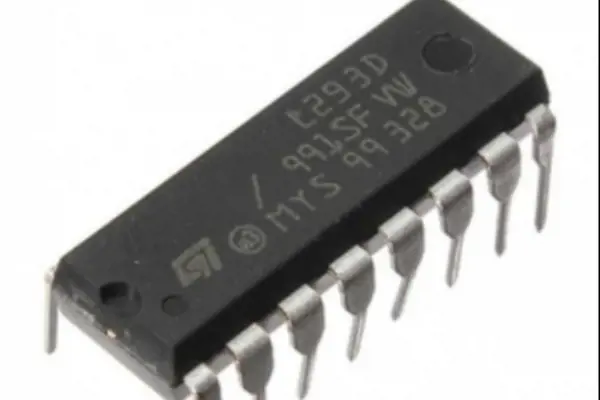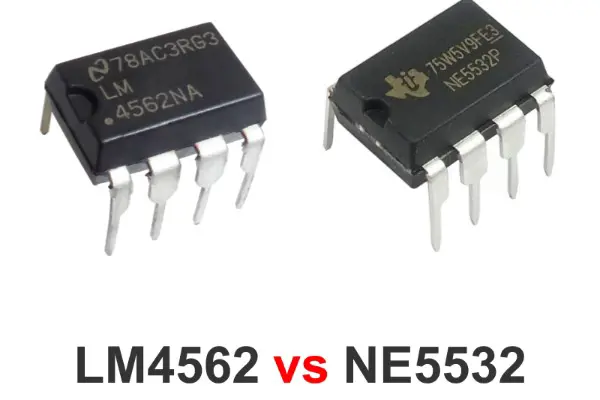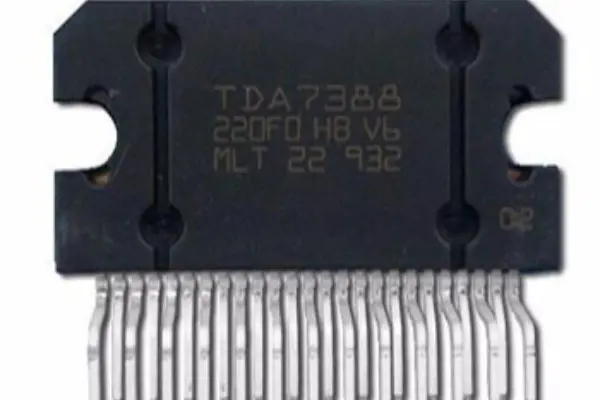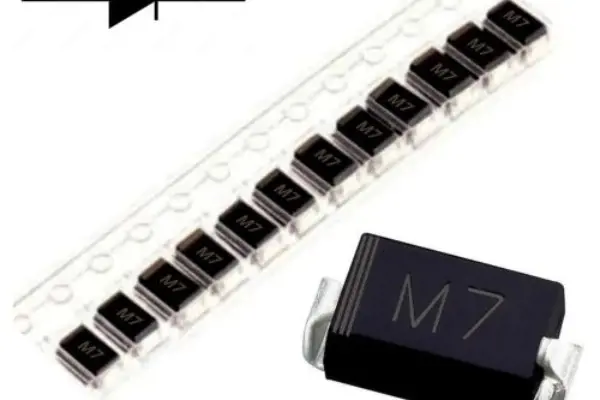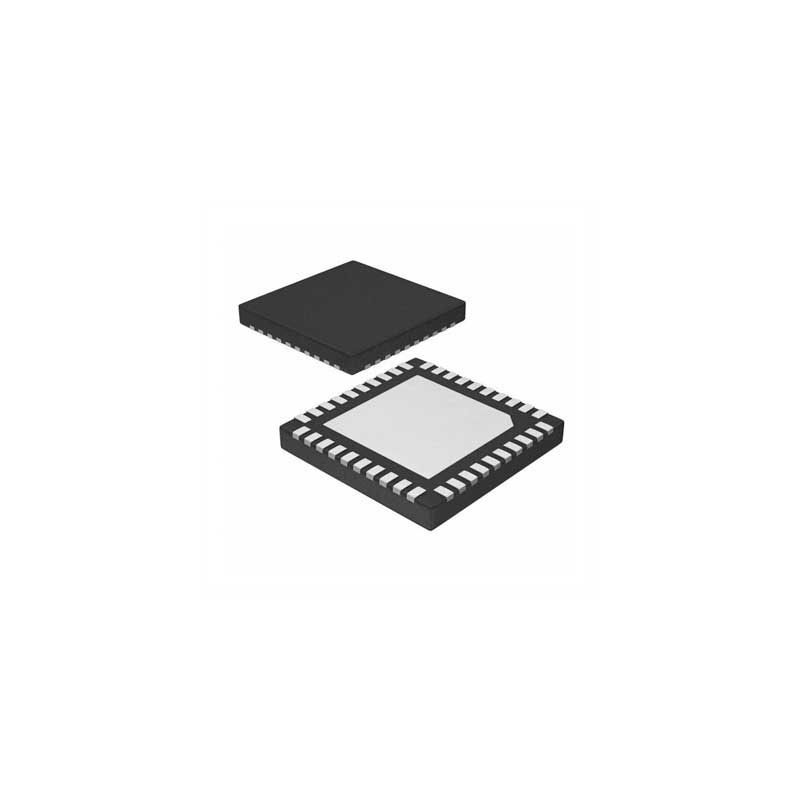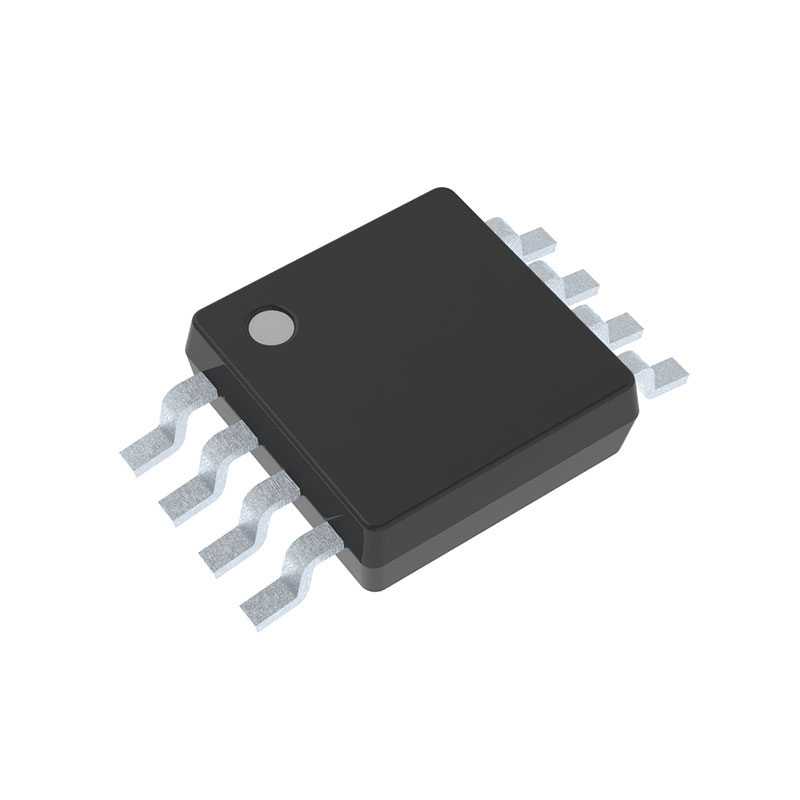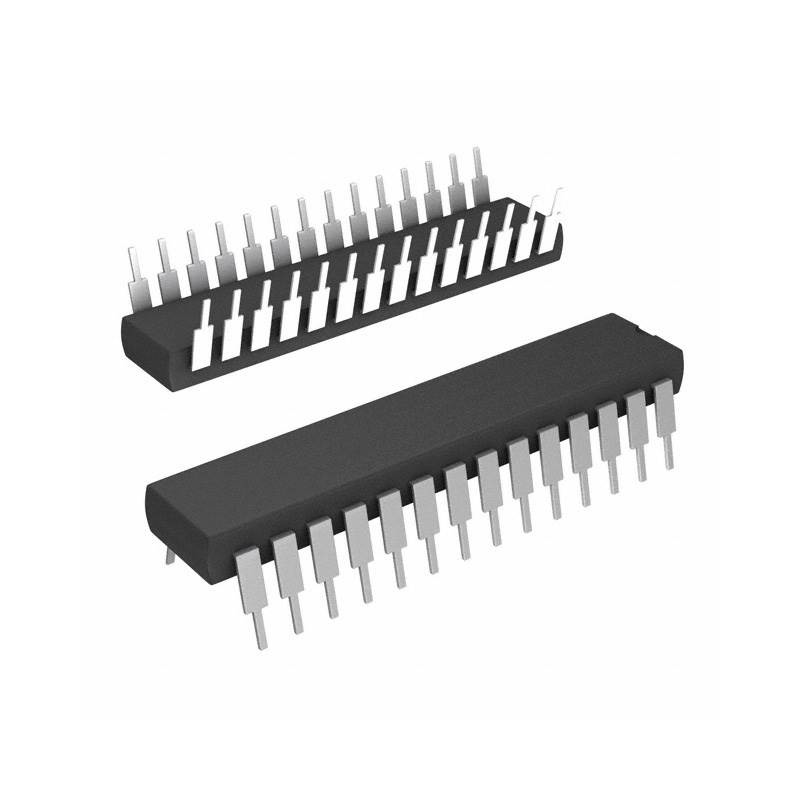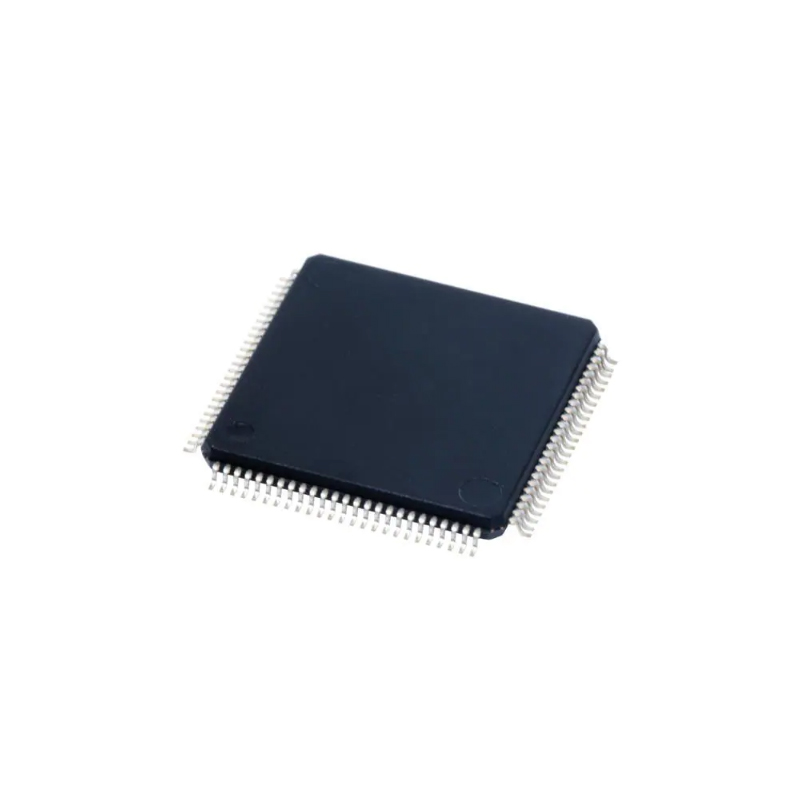TAS2560 IC: Datasheet, Features, Diagram and Application
 Published: Sep 04, 2023
Published: Sep 04, 2023
Contents
The TAS2560 integrated circuit (IC) is a testament to the advancements in audio technology, offering an exceptional audio experience in a compact package. Developed by Texas Instruments, this audio IC represents a milestone in the integration of audio processing capabilities.
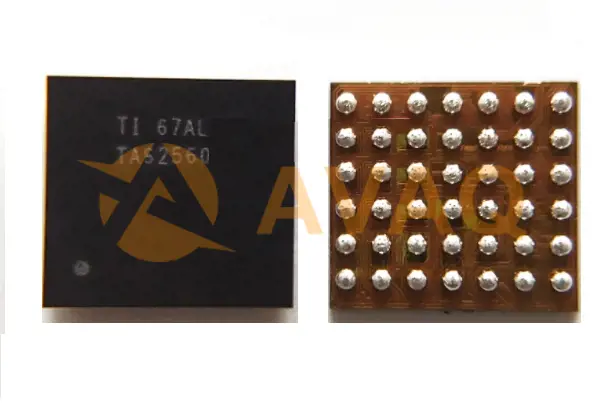
In this article, we will explore the datasheet, features, block diagram, and applications of the TAS2560 IC, providing valuable insights for those seeking to integrate this versatile component into their audio projects.
TAS2560 IC Overview
The TAS2560 is a high-performance, low-power digital input Class-D audio amplifier with an ultra-low-noise audio DAC, integrated speaker protection feedback, and a dynamic Class-H boost converter for efficient power supply management, making it ideal for both mono and stereo audio applications.
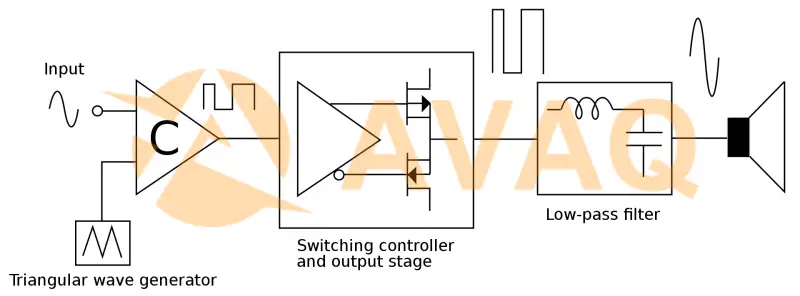
Block diagram of a basic class-D amplifier
TAS2560 IC Specification and Features
TAS2560 IC Specification
Ultra Low-Noise Mono Boosted Class-D Amplifier
- 5.6 W at 1% THD+N and 6.9 W at 10% THD+N into 4-Ω Load from 4.2-V Supply
- 3.7 W at 1% THD+N and 4.5 W at 10% THD+N into 8-Ω Load from 4.2-V Supply
Output Noise for DAC + Class-D(ICN) is 16.2 µV
DAC + Class-D SNR 111 dB at 1%THD+N / 8 Ω
THD+N –89 dB at 1 W / 8 Ω with Flat Frequency Response
Post-Filter Feedback (PFFB)
PSRR 110 dB for 200 mVpp Ripple at 217 Hz
Input Sample Rates from 8 kHz to 96 kHz
High Efficiency Class-H Boost Converter
- Automatically Adjusts Class-D Supply
- Multi-level Tracking to Improve Efficiency
Built-In Speaker Sense
- Measures Speaker Current and Voltage
- Measures VBAT Voltage, Chip Temperature
Built-In Automatic Gain Control (AGC)
- Limits Battery Current Consumption
Adjustable Class-D Switching Edge-Rate Control
Power Supplies
- Boost Input: 2.9 V to 5.5 V
- Analog/Digital: 1.65 V to 1.95 V
- Digital I/O: 1.62 V to 3.6 V
Thermal, Short-Circuit, and Under-Voltage Protection
I2S, Left-Justified, Right-Justified, DSP, and TDM, and PDM
I2C Interface for Register Control
Stereo Configuration Using Two TAS2560 Devices
TAS2560 IC Features
- Class-D Amplification: The TAS2560 uses Class-D amplifier technology, which is known for its high efficiency, making it suitable for battery-powered devices and applications where power efficiency is crucial.
- Stereo Configuration: It is typically used in a stereo configuration, providing two audio channels (left and right) for a complete stereo audio experience.
- Output Power: The TAS2560 can deliver a certain amount of output power per channel, which may vary depending on the specific implementation and supply voltage.
- Audio Processing: This IC often includes advanced audio processing features such as equalization, dynamic range compression, and other audio enhancements, which can be configured to improve sound quality.
- I2C Interface: The TAS2560 is usually controlled and configured through an I2C (Inter-Integrated Circuit) interface, allowing for easy integration into digital audio systems.
- Protection Features: It typically incorporates various protection features to ensure safe and reliable operation, such as over-temperature protection, over-current protection, and short-circuit protection.
- Low Power Consumption: The Class-D amplifier technology used in the TAS2560 helps reduce power consumption, making it suitable for battery-powered applications like smartphones, tablets, and portable speakers.
- Compact Package: The IC is often available in compact surface-mount packages, making it suitable for space-constrained applications.
- Audio Input: It accepts audio input in various formats, such as analog audio signals or digital audio data, depending on the specific model and configuration.
- Wide Voltage Range: The TAS2560 may support a wide voltage input range, making it versatile for various audio applications.
TAS2560 Functional Block Diagram
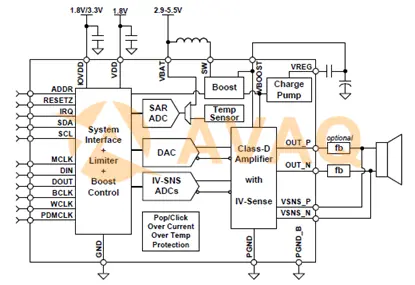
TAS2560 Functional Block Diagram
TAS2560 Stereo Configuration Chart
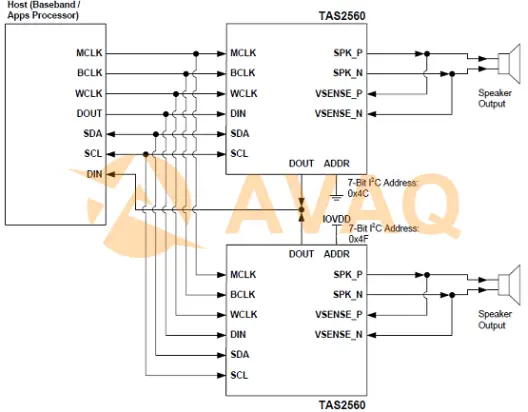
TAS2560 Stereo Configuration Chart
TAS2560 Digital Audio Input
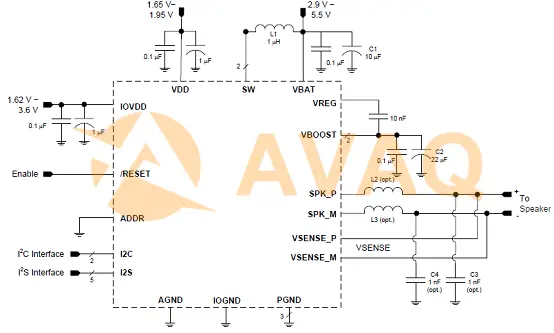
TAS2560 Digital Audio Input
TAS2560 EVM Circuit
5.6W Class D Audio Amplifier Evaluation Module TAS2560 EVM Outline Diagram

TAS2560 EVM Circuit(1)
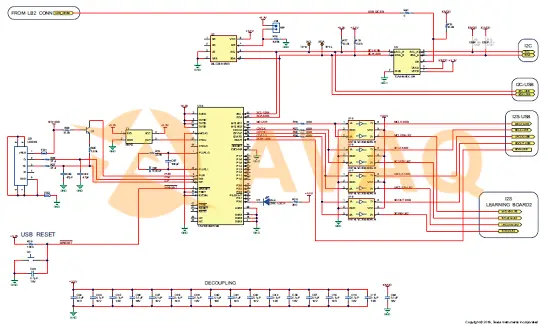 TAS2560 EVM Circuit(2)
TAS2560 EVM Circuit(2)
For Mobile App —How to Use the TAS2560 on Qualcomm Platforms
With the popular trend of thin and light smartphone products, the size of the speaker is becoming more and more limited, which causes the performance of the external playback to be difficult to improve. At the same time, audio is now a very important selling point for cell phones, and loud volume and good sound quality are very mainstream requirements in the market. So in the face of these two aspects of a Tradeoff, SmartPA in the market demand more and more.
SmartPA is mainly through the intelligent protection algorithm to achieve the protection of the speaker amplitude and speaker temperature, so as to give full play to the potential of the speaker, in the case of limited speaker space to achieve loud volume and good sound quality. This part of TI's solutions mainly include TAS2557, TAS2560 and TAS2559. for mono program, mainly built-in DSP TAS2557 and TAS2560 without DSP. for the built-in DSP program, the protection algorithm is running on the chip's internal DSP, so the realization of a relatively easier. That for the program without DSP, the protection algorithm is required to run on the platform side of the DSP, that this article is mainly for this application, introduced under the TAS2560 how to use the Qualcomm platform.
Step 1. Confirm the actual needs of the project, mainly including the following points:
- Is the project mono or stereo?
- How many bits is I2S? What is the specific format?
- What is the maximum sample rate? Generally 48K or 44.1K.
- Confirm the storage location of the algorithm related parameters, is it directly using the bin file or using Qualcomm's default acdb file?
- For SmartPA usage, how many usage scenarios are required?
- Requirements for factory calibration: Is there a standard test flow and test sound source? Are there any other requirements besides Re calibration?
Step 2. Focuses on the integration of the TAS2560 driver
This part of the TI to provide standard reference code, the implementation is relatively easy, the goal is to achieve the Speaker's normal sound. At this stage, you can directly do some tests on some electrical characteristics, such as THD + N, bottom noise, etc. to confirm whether the audio path is normal. The following points should be noted:
Confirm the format of the platform's output I2S signal, preferably reconfirmed by an oscilloscope.
Pay attention to the setting of PLL on the side of TAS2560, if there is noise problem, it is recommended to confirm whether the PLL is correct first.
Inside the driver you need to know the range of DC impedance values of the speaker.
Step3. The algorithm in the Qualcomm platform porting, the main work, as shown in the figure below, is to integrate the algorithm library of our smart amplifier and the corresponding Framework into the ADSP side of the Qualcomm platform, generally speaking, the ADSP is directly integrated into the main platform. The detailed steps are shown below:
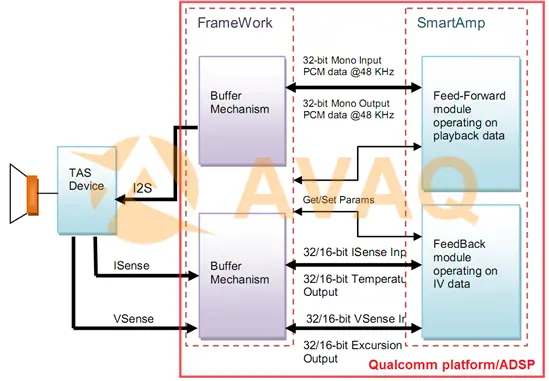
Enable the TX port of I2S on the platform side. The TX path is the path fed back from the TAS2560 to the platform.
Confirm that the feedback IV signal is correct.
DSP side and AP side related code implementation, this part is also related to the reference code for reference.
PPC3 installation, and ensure that the PPC3 and cell phone side of the communication is normal. PPC3 is a professional graphical interface tool provided by TI.
Factory calibration code implementation, pay special attention to the need to do calibration in the time to close the audio path on the algorithm.
Algorithm verification, this part of TI will also provide a standard verification process.
Step4. Modeling and tuning, this part mainly includes the following steps:
Provide the specific parameters of the horn Xmax , Tmax, Tcoef, BL and Sd and the related datasheet.
Prepare the open horn and model it using PPC3.
Rough tuning by tuning engineer.
After confirmation of the whole machine and horn, do further modeling and fine tuning on the basis of the whole machine.
TAS2560 IC Application
Here are applications of TAS2560 IC:
💎Smartphones and tablets: for enhanced audio output quality for multimedia playback and calls, and extended battery life.
💎Portable Bluetooth speakers: Provides high-quality audio amplification to ensure clear and powerful sound in a compact stereo.
💎Laptops and Ultrabooks: to enhance the quality of audio output from laptops and improve the multimedia experience.
💎Car Audio Systems: Provides a clear and immersive audio experience for car entertainment systems.
💎Smart Home Devices: for smart audio, voice assistants and home automation systems, providing high quality audio output.
💎Gaming consoles: Enhance the audio effect in gaming consoles to provide a better gaming experience.
💎Portable Media Players: Used to provide high quality audio output for portable media players.
💎Industrial Audio Systems: For public address, alarms and notifications in industrial environments.
💎Televisions: To improve the audio output of flat screen TVs and other display devices.
💎Digital Audio Workstations (DAWs): Become part of a professional audio recording and production setup for audio interfaces and mixers.
💎Wireless Headphones: Provides audio amplification for true wireless headphones while optimizing energy consumption.
💎Medical devices: Can be integrated into medical devices that require audio output, such as patient monitoring systems.
Advantages and Disadvantages of TAS2560 IC
|
Advantages (Pros) |
Disadvantages (Cons) |
|
High-Quality Audio Output: TAS2560 provides high-quality audio amplification with minimal noise, suitable for various audio applications. |
Power Supply Requirements: Like many audio amplifiers, it requires a stable power supply, which may not be ideal for extremely low-power applications. |
|
Efficient Class-D Amplification: It utilizes Class-D amplifier technology, offering high efficiency and reduced power consumption, making it suitable for battery-powered devices. |
External Components: It may require additional external components like resistors, capacitors, and inductors for optimal performance, which can increase the overall system cost and complexity. |
|
Speaker Protection: Integrated speaker voltage and current sensing feedback enhance speaker protection, preventing potential damage. |
Complexity for Beginners: Configuration and programming of advanced features may be complex for beginners or those without experience in audio electronics. |
|
Dynamic Power Management: The Class-H boost converter efficiently manages the supply voltage based on the audio signal's power requirements, improving overall system efficiency. |
Limited Features: Depending on the specific application, it may lack certain advanced audio processing features available in more specialized ICs. |
|
Battery Management: The on-chip Battery Guard system reduces audio output power during low battery voltage to prevent brownout conditions, ensuring reliable operation. |
Availability and Cost: Availability and cost can vary based on location and demand, which may affect project planning and budgets. |
|
Fault Reporting: It can detect and report faults such as brownouts, over-current, and over-temperature conditions, providing valuable feedback to the host processor for system monitoring. |
Technology Advancements: Technology is continually evolving, and newer ICs may offer improved features and efficiency compared to the TAS2560. |
TAS2560 IC Datasheet
Check and Download TAS2560 IC datasheet here>>
TAS2560 IC Manufacturer
The TAS2560 IC is manufactured by Texas Instruments (TI). Texas Instruments is a well-known semiconductor company that produces a wide range of integrated circuits and electronic components for various applications, including audio amplification and processing.
You may like: Best Audio Amplifier IC>>
Conclusion
In conclusion, the TAS2560 IC emerges as a game-changer in the world of audio electronics, offering a potent blend of features, performance, and flexibility. Its comprehensive datasheet, coupled with its versatile applications, empowers audio enthusiasts, engineers, and designers to create immersive and high-fidelity sound experiences.
Whether you're designing portable audio solutions, smart devices, or automotive audio systems, the TAS2560 IC will undoubtedly elevate the audio performance and impact of your electronic designs, immersing listeners in a world of unparalleled sound quality.
 FAQ
FAQ
- What is the power supply voltage range of the TAS2560 IC?
- The power supply voltage range for the TAS2560 can vary depending on the specific variant and application, but it is typically designed for operation with low-voltage supplies suitable for portable devices.
- Does the TAS2560 IC require external components for operation?
- Yes, it typically requires external components such as input and output coupling capacitors, power supply components, and sometimes external passive components for filtering and tuning.
- Is the TAS2560 IC compatible with digital audio input sources?
- Yes, it supports digital audio input sources like I2S (Inter-IC Sound) and PDM (Pulse Density Modulation), making it versatile for different audio input configurations.
- What types of audio processing does the TAS2560 IC support?
- The TAS2560 supports various audio processing functions, including equalization (EQ), filtering, and volume control, which can be customized to suit the specific requirements of the audio application.
- Can the TAS2560 IC be controlled and configured digitally?
- Yes, the TAS2560 IC can be controlled and configured through digital interfaces such as I2C, allowing for real-time adjustments to audio settings and performance.
TAS2560YFFR In Stock: 5115
 Popular Industry Focus
Popular Industry Focus
Hot Products
-
![TPS61372YKBR]()
TPS61372YKBR
TI
Boost Switching Regulator IC Positive Adjustable 5V 1 Output 16-XFBGA, DSBGA
-
![TPS59641RSLR]()
TPS59641RSLR
TI
D-CAP+™ Controller, Intel IMVP-7 Voltage Regulator IC 2 Output 48-VQFN (6x6)
-
![LP2951-50DR]()
LP2951-50DR
TI
Linear Voltage Regulator IC Positive Adjustable (Fixed) 1 Output 100mA 8-SOIC
-
![TLV62569PDRLR]()
TLV62569PDRLR
TI
Buck Switching Regulator IC Positive Adjustable 0.6V Output 2A SOT-563, SOT-666
-
![TPS565208DDCR]()
TPS565208DDCR
TI
Buck Switching Regulator IC Positive Adjustable 0.76V 1 Output 5A SOT-23-6 Thin, TSOT-23-6
-
![LM10011SD/NOPB]()
LM10011SD/NOPB
TI
- Controller, 4-bit or 6-bit VID Voltage Regulator IC 1 Output 10-SON (3x3)
Related Parts
-
![TDA8566TH]()
TDA8566TH
PHILIPS SEMICONDUCTORS
Amplifier IC 2-Channel (Stereo) Class B 20-HSOP
-
![TPA6203A1ZQVR]()
TPA6203A1ZQVR
TI
Amplifier IC 1-Channel (Mono) Class AB 8-BGA Microstar Junior (2x2)
-
![PCM1753DBQ]()
PCM1753DBQ
Burr Brown
DAC, Audio 24 b 200k I2S 16-SSOP
-
![INA2137UA]()
INA2137UA
Burr Brown
Differential Receiver IC Audio 14-SOIC
-
![NJM2073D]()
NJM2073D
Nisshinbo Micro Devices
8-Pin PDIP Package Speaker Amplifier for Single or Stereo Use
-
![IRS20957STRPBF]()
IRS20957STRPBF
Infineon
High-Quality Protected Digital Audio Amplifier
-
![CS4344-CZZ]()
CS4344-CZZ
Cirrus Logic Inc.
Audio D/A Converter ICs Stereo DAC 24-Bit 192kHz
-
![TAS2505IRGET]()
TAS2505IRGET
TI
2-W, mono, digital & analog input Class-D audio amp with audio processing & mono headphone amplifier
-
![TPA6211A1TDGNRQ1]()
TPA6211A1TDGNRQ1
TI
Automotive, 3.1-W, mono, analog input Class-AB audio amplifier
-
![ADAU1701JSTZ-RL]()
ADAU1701JSTZ-RL
Analog Devices, Inc
SigmaDSP<sup>®</sup> 28/56-Bit Audio Processor with Two ADCs and Four DACs
-
![PCM6240QRTVRQ1]()
PCM6240QRTVRQ1
TI
Automotive, 4-channel audio ADC with integrated programmable mic bias & input diagnostics
-
![ES9842QPRO]()
ES9842QPRO
ess technology
Audio D/A Converter ICs Sabre 4 channel reference PRO ADC
-
![LM4881MM]()
LM4881MM
Texas Instruments
Amplifier IC Headphones, 2-Channel (Stereo) Class AB 8-VSSOP
-
![CS5126-KP]()
CS5126-KP
Cirrus Logic Inc.
Audio A/D Converter ICs IC 16-Bit Str Audio ADC F/Digital Audio
-
![ZL38004QCG1]()
ZL38004QCG1
Microchip
Audio DSPs Voice Processor with Dual Wideband Codec

 Update Time: Sep 07, 2023 Consumer Electronics
Update Time: Sep 07, 2023 Consumer Electronics